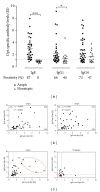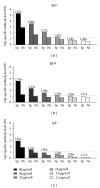Allergen-specific IgG antibodies purified from mite-allergic patients sera block the IgE recognition of Dermatophagoides pteronyssinus antigens: an in vitro study
- PMID: 24069042
- PMCID: PMC3771262
- DOI: 10.1155/2013/657424
Allergen-specific IgG antibodies purified from mite-allergic patients sera block the IgE recognition of Dermatophagoides pteronyssinus antigens: an in vitro study
Abstract
One of the purposes of specific immunotherapy (SIT) is to modulate humoral immune response against allergens with significant increases in allergen-specific IgG levels, commonly associated with blocking activity. The present study investigated in vitro blocking activity of allergen-specific IgG antibodies on IgE reactivity to Dermatophagoides pteronyssinus (Dpt) in sera from atopic patients. Dpt-specific IgG antibodies were purified by ammonium sulfate precipitation followed by protein-G affinity chromatography. Purity was checked by SDS-PAGE and immunoreactivity by slot-blot and immunoblot assays. The blocking activity was evaluated by inhibition ELISA. The electrophoretic profile of the ammonium sulfate precipitated fraction showed strongly stained bands in ligand fraction after chromatography, compatible with molecular weight of human whole IgG molecule. The purity degree was confirmed by detecting strong immunoreactivity to IgG, negligible to IgA, and no reactivity to IgE and IgM. Dpt-specific IgG fraction was capable of significantly reducing levels of IgE anti-Dpt, resulting in 35%-51% inhibition of IgE reactivity to Dpt in atopic patients sera. This study showed that allergen-specific IgG antibodies purified from mite-allergic patients sera block the IgE recognition of Dermatophagoides pteronyssinus antigens. This approach reinforces that intermittent measurement of serum allergen-specific IgG antibodies will be an important objective laboratorial parameter that will help specialists to follow their patients under SIT.
Figures





Similar articles
-
IgE, IgG1, and IgG4 Reactivity to Dermatophagoides pteronyssinus Glycosylated Extract in Allergic Patients.Biomed Res Int. 2019 Jul 29;2019:9840890. doi: 10.1155/2019/9840890. eCollection 2019. Biomed Res Int. 2019. PMID: 31467923 Free PMC article.
-
Characterization of a hybrid protein designed with segments of allergens from Blomia tropicalis and Dermatophagoides pteronyssinus.Immunol Lett. 2018 Apr;196:103-112. doi: 10.1016/j.imlet.2018.01.012. Epub 2018 Feb 3. Immunol Lett. 2018. PMID: 29408409
-
Carrier-bound nonallergenic Der p 2 peptides induce IgG antibodies blocking allergen-induced basophil activation in allergic patients.Allergy. 2012 May;67(5):609-21. doi: 10.1111/j.1398-9995.2012.02794.x. Epub 2012 Feb 17. Allergy. 2012. PMID: 22339348 Free PMC article.
-
Renaissance of the blocking antibody concept in type I allergy.Int Arch Allergy Immunol. 2003 Sep;132(1):13-24. doi: 10.1159/000073260. Int Arch Allergy Immunol. 2003. PMID: 14555854 Review.
-
Allergen-Specific Antibodies Regulate Secondary Allergen-Specific Immune Responses.Front Immunol. 2019 Jan 17;9:3131. doi: 10.3389/fimmu.2018.03131. eCollection 2018. Front Immunol. 2019. PMID: 30705676 Free PMC article. Review.
Cited by
-
Allergen-specific IgE and IgG4 patterns among patients with different allergic diseases.World Allergy Organ J. 2018 Dec 3;11(1):35. doi: 10.1186/s40413-018-0220-5. eCollection 2018. World Allergy Organ J. 2018. PMID: 30524646 Free PMC article.
-
IgE, IgG1, and IgG4 Reactivity to Dermatophagoides pteronyssinus Glycosylated Extract in Allergic Patients.Biomed Res Int. 2019 Jul 29;2019:9840890. doi: 10.1155/2019/9840890. eCollection 2019. Biomed Res Int. 2019. PMID: 31467923 Free PMC article.
-
Antigenic cross-reactivity between Schistosoma mansoni and peanut: a role for cross-reactive carbohydrate determinants (CCDs) and implications for the hygiene hypothesis.Immunology. 2017 Apr;150(4):506-517. doi: 10.1111/imm.12711. Epub 2017 Feb 15. Immunology. 2017. PMID: 28201853 Free PMC article.
-
Particularities of allergy in the Tropics.World Allergy Organ J. 2016 Jun 27;9:20. doi: 10.1186/s40413-016-0110-7. eCollection 2016. World Allergy Organ J. 2016. PMID: 27386040 Free PMC article. Review.
-
Good clinical practice recommendations in allergen immunotherapy: Position paper of the Brazilian Association of Allergy and Immunology - ASBAI.World Allergy Organ J. 2022 Sep 24;15(10):100697. doi: 10.1016/j.waojou.2022.100697. eCollection 2022 Oct. World Allergy Organ J. 2022. PMID: 36254179 Free PMC article. Review.
References
-
- Calderón MA, Casale TB, Togias A, Bousquet J, Durham SR, Demoly P. Allergen-specific immunotherapy for respiratory allergies: from meta-analysis to registration and beyond. Journal of Allergy and Clinical Immunology. 2011;127(1):30–38. - PubMed
-
- Tovey ER, Chapman MD, Platts-Mills TAE. Mite faeces are a major source of house dust allergens. Nature. 1981;289(5798):592–593. - PubMed
-
- Pawankar R, Canonica GW, Holgate ST, Lockey RF. Allergic diseases and asthma: a major global health concern. Current Opinion in Allergy and Clinical Immunology. 2012;12(1):39–41. - PubMed
-
- Larché M, Akdis CA, Valenta R. Immunological mechanisms of allergen-specific immunotherapy. Nature Reviews Immunology. 2006;6(10):761–771. - PubMed
Publication types
MeSH terms
Substances
LinkOut - more resources
Full Text Sources
Other Literature Sources
Miscellaneous

